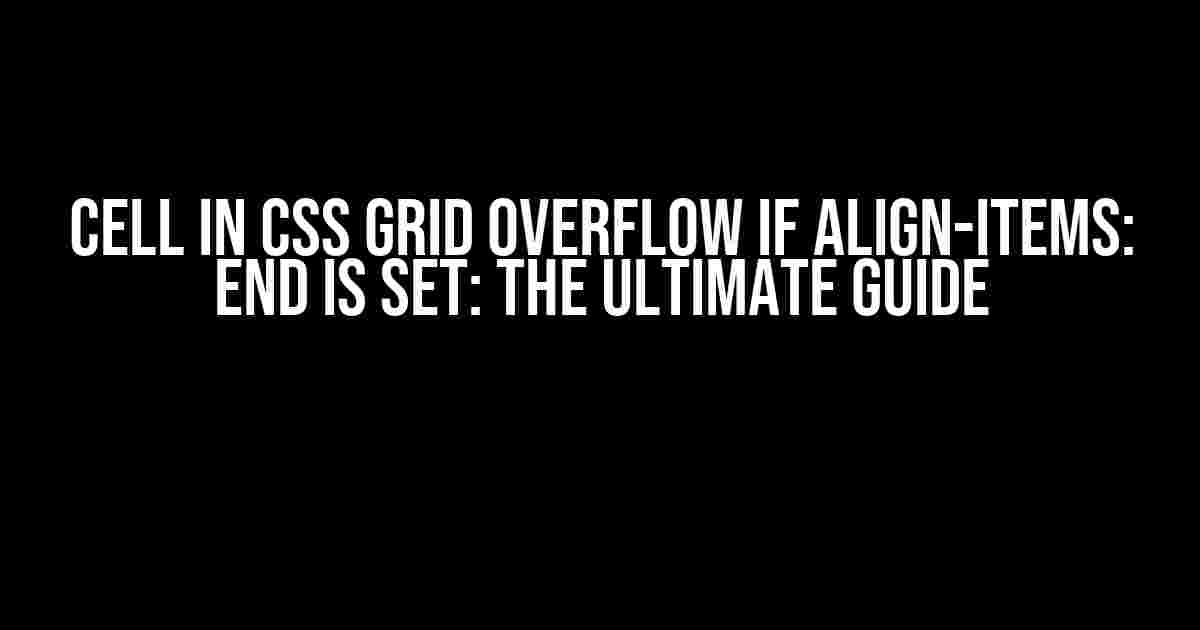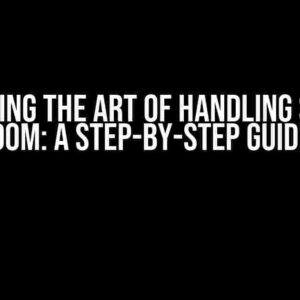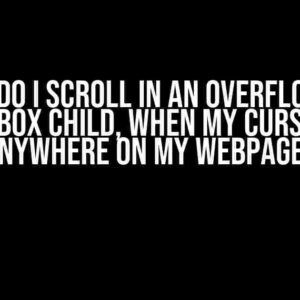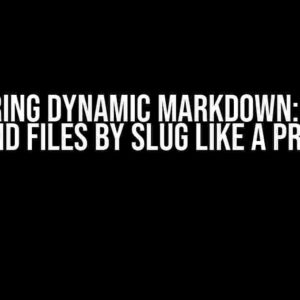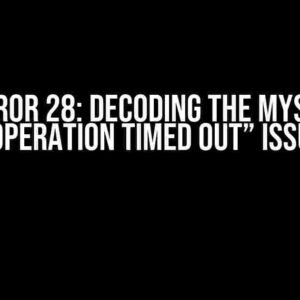Are you tired of dealing with pesky overflow issues in your CSS grid when using align-items: end? You’re not alone! Many developers have been there, done that, and got the t-shirt. But fear not, dear reader, for today we’re going to tackle this problem head-on and provide you with the ultimate solution.
Understanding the Problem
Before we dive into the solution, let’s take a step back and understand the problem. When you use align-items: end in a CSS grid, it’s like telling the grid to “Hey, align these items to the end of the grid cell”. Sounds simple, right? But here’s the catch: what happens when the content of the grid cell overflows? You guessed it – chaos ensues!
When the content overflows, it can lead to a range of problems, including:
- Visual clutter
- Inconsistent layout
- Difficulty in reading and navigating the content
The Causes of Overflow
So, what causes this overflow issue in the first place? Well, it’s often a combination of factors, including:
- Content size: When the content is too large for the grid cell, it’s going to overflow. Simple as that!
- Grid cell size: If the grid cell is too small, it can’t accommodate the content, leading to overflow.
- Margin and padding: Adding margin and padding to the grid cell or its contents can push the content out of bounds, causing overflow.
- Other styles: Other styles, such as borders, shadows, and outlines, can also contribute to overflow.
The Solution: Using overflow property
Now that we’ve identified the problem, let’s talk about the solution. The secret to taming the overflow beast lies in using the overflow property. Yes, you heard that right – the overflow property is your new best friend!
.grid-cell {
overflow: auto;
}
By setting overflow: auto on the grid cell, you’re telling the browser to add a scrollbar when the content overflows. This way, the user can still access the content, even if it’s too large for the grid cell.
Other Solutions: Using max-width and flexbox
While the overflow property is a great solution, it’s not the only one. Depending on your specific use case, you might want to consider using max-width or flexbox to solve the overflow issue.
Using max-width
.grid-cell {
max-width: 100%;
overflow: hidden;
}
By setting max-width: 100% and overflow: hidden, you’re telling the grid cell to respect its boundaries and hide any excess content.
Using flexbox
.grid-cell {
display: flex;
flex-direction: column;
overflow: hidden;
}
By using flexbox, you can create a flexible grid cell that adapts to its content. The flex-direction: column property tells the grid cell to stack its contents vertically, and overflow: hidden hides any excess content.
Real-World Examples
Let’s take a look at some real-world examples to see how these solutions play out in practice.
| Example | Code | Description |
|---|---|---|
| Basic Grid |
|
A basic grid with three columns and grid gap. |
| Grid with Overflow |
|
A grid cell with align-items: end and overflow: auto. |
| Grid with max-width |
|
A grid cell with max-width: 100% and overflow: hidden. |
| Grid with Flexbox |
|
A grid cell using flexbox with flex-direction: column and overflow: hidden. |
Best Practices
Now that we’ve explored the solutions, let’s talk about some best practices to keep in mind when dealing with overflow in CSS grid:
- Test thoroughly: Test your grid layout with different content sizes and styles to ensure it’s working as expected.
- Use overflow: auto wisely: Only use overflow: auto when necessary, as it can affect the layout and usability of your grid.
- Keep it simple: Avoid overly complex grid layouts and styles, as they can lead to harder-to-debug issues.
- Use grid-template-rows and grid-template-columns wisely: Use these properties to define the grid structure and prevent overflow issues.
Conclusion
And there you have it, folks! Dealing with overflow in CSS grid when using align-items: end is no longer a mystery. By using the overflow property, max-width, and flexbox, you can create beautiful and functional grid layouts that adapt to different content sizes and styles.
Remember to test thoroughly, keep it simple, and use best practices to ensure your grid layout is both visually appealing and user-friendly.
Thanks for reading, and happy coding!
Frequently Asked Question
Get ready to unravel the mysteries of CSS Grid and its quirky behavior when dealing with overflowing cells and align-items: end!
Why does my cell in CSS Grid overflow when I set align-items: end?
When you set align-items: end on a grid container, it aligns the items to the end of the container, but it doesn’t magically make the container grow to fit the content. If the content is larger than the container, it will overflow! To fix this, you can set overflow: auto on the container or adjust the grid-template-rows/grid-template-columns to accommodate the content.
What happens when I set align-items: end on a grid item instead of the grid container?
When you set align-items: end on a grid item, it aligns the item within its own grid cell, but it won’t affect the overall flow of the grid. The item will still take up the space allocated to it by the grid, and if it’s larger than the cell, it will overflow. So, be careful not to confuse this with setting align-items: end on the grid container!
Can I use flexbox instead of CSS Grid to avoid the overflow issue?
Yes, you can use flexbox as an alternative to CSS Grid, and it might be a better choice if you’re dealing with a simple one-dimensional layout. However, keep in mind that flexbox has its own set of quirks and limitations. If you need a more complex grid-based layout, CSS Grid is still the way to go!
What about using overflow: hidden on the grid container? Will that fix the issue?
While setting overflow: hidden on the grid container might seem like a quick fix, it’s not always the best solution. This approach can lead to content being cut off or hidden, which might not be what you want. Instead, consider adjusting the grid-template-rows/grid-template-columns or setting overflow: auto to create a scrollbar when necessary.
Are there any browser-specific issues with CSS Grid and align-items: end that I should know about?
As with any new technology, there might be some browser-specific quirks with CSS Grid. However, align-items: end is a well-supported property across modern browsers, including Chrome, Firefox, and Safari. If you do encounter issues, make sure to check the browser’s support for CSS Grid and the specific property you’re using.

